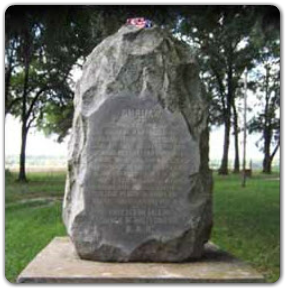HISTORY
Lee County was created by an act of the Georgia General Assembly on December 11, 1826. However, the county's organization was considered official by a legislative act on December 20, 1832. Lee County was one of Georgia's original 32 counties. The act creating Lee County stated: "to organize the territory lately acquired from the Creek Indians, lying between the Flint and Chattahoochee Rivers, immediately above the old line of Early County, and known as the first section, shall form one county to be called Lee." Initially, Lee County comprised the subsequently created counties of Quitman, Randolph, Stewart, Sumter, Terrell, and Webster, parts of Schley, Chattahoochee, Macon, Clay, and Marion. The original county seat was designated at Starksville. In 1873, the county seat was moved from Starksville to Wooten Station, later known as Leesburg, the current county seat.
While there remains some question, it is generally held that Lee County was named after Major General Henry Lee, universally known as "Light Horse Harry." Born at Leesylvania near Dumfries, Virginia, Harry was blonde, blue-eyed, and full of spirit. He graduated from Princeton in 1773 and returned home to prepare for war. His skill as a horseman, as well as his temperament, made him a natural cavalryman. He soon was commissioned as a captain in the fifth group of Virginia Light Dragoons and sent north to join the Continental Army.
Leading his men on lightning raids against enemy supply trains, Harry attracted the attention and admiration of General George Washington and was rapidly promoted. In a surprise attack at Paulus Hook, New Jersey, he captured 400 British soldiers with only one man's loss. His adroit horsemanship soon earned him the nickname "Light Horse Harry." When the military theatre shifted, he enjoyed equal success in the Southern Department.
Resigning his commission after the British surrender at Yorktown, Harry returned to Virginia to marry his cousin, the
"divine Matilda" Lee. The wedding took place at Stratford, and it is said that General Washington contributed several pipes of his best Madeira to the festive occasion. Matilda had inherited Stratford in her father's estate division and lived there with her new husband. The dashing young cavalryman, however, was no farmer. His interests in the livelier politics arena led to Harry's election to the new Virginia House of Delegates. After only eight years of marriage, Matilda died in 1790, leaving three young children and a husband desperate with grief.
Two years later, Harry was elected Governor of Virginia, serving three one-year terms. While living in Richmond, he fell in
love with Ann Hill Carter of nearby Shirley Plantation. In 1793 they were married. His governorship behind him, he took his bride to Stratford.
Again, family life was interrupted by his appointment to the Continental Congress in Philadelphia. Upon the death of
President George Washington, Harry was asked by Congress to deliver a tribute to his beloved general, describing him for posterity:
First in war, first in peace, and first in the hearts of his countrymen...second to none in the humble and endearing scenes of private life.
After the death of his idol, Harry's fortunes began to decline rapidly. Supporting a family of six, coupled with disastrous
land speculation, reduced him to financial poverty. Then, on January 19, 1807, in the large upstairs room at Stratford where so many Lee's had come into the world, Ann gave birth to their fifth son, Robert Edward, named after two of his
mother's favorite brothers.
As Robert was learning to walk, his father was carried off to the debtor's prison in Montross. With characteristic courage, in a 12-by-15 foot prison cell, Harry wrote his Memoirs of the War in the Southern Department of the United States, still the standard text on that portion of the Revolutionary War. When the book was completed in 1810, the family moved to Alexandria, where a new life on a modest scale was made possible by a legacy from Ann's father.
Harry's eldest son, Henry IV, became master of Stratford. "Light Horse Harry's" last years were marred by sorrow and pain. Internal injuries, received when a mob beat him as he defended a friend and freedom of the press in Baltimore, kept him in constant physical pain. He sought relief in the warm climate of the West Indies. When his health continued to decline, Harry attempted to return home but died March 25, 1818, on Cumberland Island, Georgia, and was buried at Dungeness (General Nathaniel Greene's summer home on Cumberland Island). His body remained at Dungeness until 1913, when it was moved and reinterred in the Lee Mausoleum at Lexington, Virginia, next to his famous son, General Robert E. Lee.


